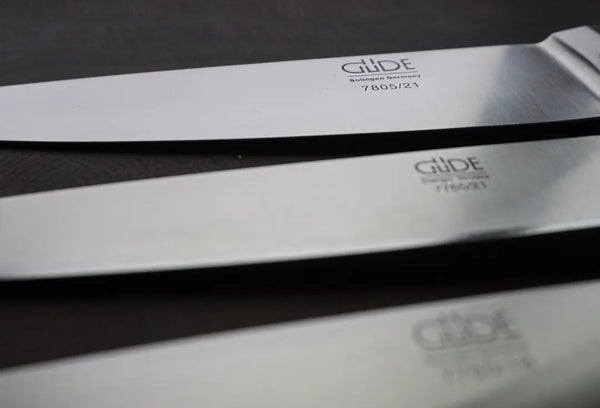
Knife care – 9 brilliant tips for a long knife life
Proper knife care: with these simple 9 tips, your knife will last a long time
We all know this sentence “A knife has no place in the dishwasher” and yet the temptation sometimes big, because let's be honest, it's so simple. Open the lid, insert the knife, and close the lid. It seems At first glance it is great, the workload is reduced to a minimum, but sooner or later you will You may be annoyed by a blunt blade or even rust. High-quality knives do not require much care, only a little attention and you can enjoy a well-functioning knife for a lifetime, from which you You can say that this investment was truly worth it. So what should you keep in mind when caring for your knife? We have put together our 9 best tips for a long knife life.
Gentle knife cleaning
When things get hot in the kitchen, it is probably this one word that we think can save our lives. sweetened: dishwasher safe. Many knife manufacturers, yes, even these really first-class and high-priced knives, state that their pieces are dishwasher-safe. Please just ignore that, Because absolutely no knife belongs in the dishwasher. The consequences are rust, corrosion and in any case a blunt blade. The process is gradual and initially goes unnoticed, but the combination of aggressive detergents, heat and water will inevitably lead to the demise of your knife. Mechanical Damage does the rest and the kitchen drama is complete.
It is best to clean your knife by hand under running, warm water and immediately after use, so that the food residues do not dry out. If scratches appear on the blade, we recommend using a mild cleaning agent without abrasive particles. Then simply use a soft Dry the cotton cloth and put it back in its storage place.
"Good knives last a lifetime. With proper knife care, they last even longer!"

Knife care
In order to properly care for the blade and handle of each knife and to protect it from rust, corrosion or To protect your knife from discoloration, we recommend using a special knife oil. Due to its high pH value, camellia oil is one of these special oils.
This oil covers the blade with a protective film and does not stick, so it is It provides optimal corrosion protection and prevents rust from forming. Does your knife also have a wooden handle? Perfect! You can also use the purely plant-based camellia oil to protect the handle use – an absolute advantage if you don’t want to have various care products in your cupboard. quickly penetrates the wood and protects it from brittleness, cracks and moisture, but also from Stains such as blood or fruit acid.
The icing on the cake of this type of knife care is probably the special shine that appears on the blade. This is an absolute feast for the eyes, especially with knives with individual contours.
Of course, you do not have to perform this procedure after every use, but a certain regularity makes perfect sense, especially since knife care with camellia oil is so easy. Just add a few drops of oil onto a cotton pad or a microfiber cloth and carefully coat your knife with it. Then Let the oil soak into the knife and then it is ready for its next use.
Erecting & regrinding
Yes, this is also an aspect that definitely belongs to knife care. Because if there is more to a squeezing and pressing marathon, rather than cutting fine slices cleanly from the tomato with little effort. cutting, it is high time to sharpen your knife. In most cases, the cutting edge of the knife has just a little and you can straighten this ridge again with a sharpening steel . Is that If the result is still not beneficial to the tomato slices, the knife should, depending on the type, be placed on a Grinding stone can be reground.
But be careful: just as there are different types of knives, there are also different types of The right method makes the music here – so if you are unsure, don’t be afraid not to contact us. In addition, we will shortly publish a corresponding blog article. In the In the meantime, you can read up on the subject here at the GÜDE knife manufacturer.
Type of storage
In addition to gentle cleaning, the way you store your knives is also an important factor in knife care. Knife blades are beautiful and sturdy, but nevertheless delicate. Regardless of the risk of injury that a loose storage entails storage in drawers or cutlery boxes scratches quickly. Friction with other kitchen utensils causes the blade to become blunt. For correct storage, knife boxes , knife blocks or Magnetic rails .
Use when cutting
In addition to the gentle knife cleaning, the regrinding and the type of storage, the type and how to use a knife is important. With the right cutting technique , you will have something from your knives and the blade is protected. So cut as straight as possible and without too much effort, because by pushing, levering or turning you load the blade laterally and thus ensure increased Wear, nicks or unwanted breakouts.
But that's not all, proper knife care begins with the choice of the surface . Glass, Ceramic or even marble are rather unyielding partners and ensure that the knife edge quickly becomes blunt or suffers even greater damage. It is best to use boards made of bamboo , acacia or oak , creating a rather soft surface. Because who doesn't like soft bedded?
Different types of knives admittedly also have different areas of use Have you ever tried to chop something with a filleting knife? Not a good idea: The knife would suffer considerably and may even break the blade. So always try to Choose a knife that lives up to its characteristics. Check out our blog article 8 great knife types that will take your kitchen to the next level – there we present the most common kitchen knives and their uses.
Our 9 ingenious tips for proper knife care at a glance
- Clean your knife immediately after use to prevent food residue from drying out
- Running, lukewarm water and a mild detergent are the means of choice
- After cleaning, dry thoroughly with a soft cotton cloth
- Knife care of blade and handle with acid-free oil (e.g. camellia oil) against rust, dirt adhesion and corrosion
- Straightening and resharpening your knife with a sharpening steel or whetstone
- Storing your knife on a magnetic rail or in a knife block to prevent scratches and chips avoid
- a cutting technique that is as straight as possible without much effort
- Use a soft surface when cutting (wood instead of glass, ceramic or marble)
- Use knives only according to their characteristics
This way, you have all the tips summarized clearly. If you still have questions, don't hesitate to ask. We will be happy to assist you with advice and support. And once everything is clear, the next kitchen battle, right?












